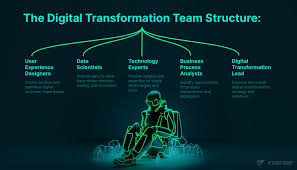Introduction to Digitalization in Business
Digitalization has emerged as a transformative force in the contemporary business landscape, fundamentally reshaping traditional business models into innovative, digital-centric frameworks. At its core, digitalization involves the integration of digital technologies into every aspect of a business’s operations. This shift allows organizations to streamline processes, improve efficiency, and deliver superior customer experiences. As businesses increasingly navigate the complexities of a fast-paced market, the significance of digital transformation has never been more apparent.
The benefits of adopting digital technologies are manifold. Firstly, digitalization enables businesses to enhance operational efficiency by automating workflows and reducing manual interventions. Through advanced data analytics, organizations can gain valuable insights into their operations, which allows for the identification of bottlenecks and the optimization of resources. This efficiency not only saves time and costs but also enhances productivity, leading to improved overall business performance.
Furthermore, a digital-driven enterprise fosters an enhanced customer experience. Digital technologies facilitate real-time interactions and personalized services, empowering businesses to meet customer expectations more effectively. By leveraging tools such as customer relationship management (CRM) systems and digital marketing strategies, companies can engage with their clients on a deeper level. This heightened interaction contributes to customer loyalty and retention, which are crucial in today’s competitive environment.
In addition, digitalization positions businesses to compete more effectively in a rapidly changing market. Companies equipped with digital capabilities can swiftly adapt to evolving trends and consumer demands, ensuring they remain relevant. The transition from traditional business models to digital frameworks not only prepares organizations for current challenges but also paves the way for future opportunities.
Understanding Traditional Business Models
Traditional business models refer to the established ways through which companies operate, generate revenue, and deliver value to customers. Typically, these models have been characterized by physical storefronts, direct customer interactions, and a reliance on traditional marketing strategies. Examples include retail shops, service-based businesses, and manufacturing firms, each possessing a unique set of operational practices that have evolved over decades.
One of the primary characteristics of traditional business models is their focus on face-to-face interactions and tangible product offerings. This allows companies to build strong relationships with customers and create community-based value. Additionally, these models often rely on tried-and-tested revenue generation methods, such as selling products directly to consumers or providing services in person. The strengths of these traditional approaches include brand loyalty and a clear understanding of local market demands, which can drive customer retention.
However, in today’s rapidly changing economy, the limitations of traditional business models have become increasingly apparent. The advent of technology has reshaped customer expectations, as individuals now seek convenience, speed, and personalization in their purchasing experiences. Traditional business models may struggle to adapt to these new demands, particularly if they remain heavily anchored in conventional practices. Moreover, the competitive landscape has evolved, with digital-first or tech-savvy companies entering the market and appealing to the modern consumer’s preferences.
In light of these developments, many organizations are recognizing the need to evaluate and potentially transform their traditional business models. By understanding the strengths and shortcomings of these established frameworks, businesses can identify the opportunities that digitalization presents. This transition is not just a trend but essential for maintaining relevance and competitiveness in an increasingly digital world.
Key Drivers of Digital Transformation
In recent years, the landscape of business has undergone profound changes, necessitating a shift towards digital transformation. Key drivers include changing consumer behaviors, technological advancements, and competitive pressures, each acting as a catalyst for organizations to adapt and innovate. Understanding these drivers is crucial for businesses aiming to thrive in a digital-driven environment.
Consumer behavior has evolved significantly, with a growing preference for seamless and immediate online interactions. Today’s customers expect personalized experiences, fast service, and access to products at their fingertips. This shift compels organizations to implement digital strategies that cater to evolving preferences and enhance customer satisfaction. Companies that fail to recognize this trend risk losing market share to those that effectively leverage digital channels.
Technological advancements play a pivotal role as well. The proliferation of mobile technology has transformed how consumers interact with brands. Mobile devices enable users to access information and make purchases anytime and anywhere, thus fostering an unprecedented demand for mobile-friendly solutions. Additionally, innovations in data analytics have empowered businesses to gain valuable insights into customer preferences, allowing for more informed decision-making and targeted marketing strategies.
Moreover, the rise of e-commerce has revolutionized traditional retail models. With the convenience of online shopping, businesses are increasingly compelled to establish a robust digital presence. This transition not only helps capture new customer segments but also enhances operational efficiency through streamlined processes and reduced overhead costs.
Lastly, competitive pressures drive organizations towards digital transformation. As more companies embrace digitization, staying competitive requires businesses to adapt quickly and effectively. Those that harness digital tools and technologies gain a significant advantage, positioning themselves for long-term success in an ever-evolving marketplace.
Benefits of Transitioning to a Digital Business Model
In an era marked by rapid technological advancements, transitioning to a digital business model offers both tangible and intangible benefits that can significantly enhance an organization’s overall performance. One of the primary advantages of embracing a digital model is the increased operational efficiency it brings. By automating various processes and utilizing cloud-based solutions, companies are able to streamline their operations, reduce manual errors, and lower costs. For instance, companies like Amazon have leveraged sophisticated logistics and automation technology to optimize their supply chain, thus achieving remarkable efficiency.
Furthermore, a digital business model broadens an organization’s market reach. Traditional geographical boundaries dissolve in the digital landscape, allowing businesses to connect with customers globally. This access to a larger audience not only facilitates a greater volume of sales but also enables businesses to engage in international markets without hefty initial investment costs. For example, companies such as Shopify empower small local retailers to establish an online presence, broadening their reach and customer base.
Improved customer engagement is another profound benefit of adopting a digital approach. With the integration of data analytics and customer relationship management (CRM) systems, businesses can personalize their interactions and foster stronger relationships with their customers. Digital channels allow organizations to gather insights about customer preferences and behaviors, enabling them to customize offerings and enhance customer satisfaction. Companies like Netflix successfully utilize data analytics to tailor content to specific user interests, leading to increased viewer retention and loyalty.
Lastly, enhanced flexibility is a crucial aspect of digital business models. Organizations can rapidly adapt to market changes and consumer demands, which is essential in today’s dynamic business environment. Digital tools allow for quicker product development cycles and easy adjustments to marketing strategies. As demonstrated by companies like Slack, which swiftly adapted their communication platforms in response to the pandemic, the agility provided by digital transformations is indispensable for long-term success.
Challenges in Digital Transformation
The journey from traditional business models to digital-driven enterprises is fraught with challenges. One of the most significant hurdles is the inherent resistance to change often found within organizations. Employees may be accustomed to established routines and practices, leading to apprehension regarding new digital technologies. This resistance can inhibit innovation and slow down the adoption of necessary digital tools. To combat this, effective change management strategies that involve communication, training, and support play a critical role in easing the transition.
Another challenge that businesses frequently encounter during their digital transformation initiatives is the lack of digital skills among employees. Many organizations find that their workforce lacks the necessary technical knowledge to leverage new technologies effectively. This skills gap can hinder a company’s ability to implement digital solutions and extract maximum value from them. To address this issue, companies should invest in comprehensive training programs and workshops aimed at upskilling their employees. Additionally, hiring new talent with the requisite skills can bolster the organization’s capabilities, facilitating smoother transformation processes.
Data security concerns also present a significant challenge as businesses transition into the digital realm. The fear of potential breaches or data losses can create hesitation among stakeholders. Organizations must prioritize establishing robust cybersecurity measures to protect sensitive information and maintain customer trust. Furthermore, fostering a culture of data privacy and awareness through employee training is essential in safeguarding against potential risks.
Lastly, the digital transformation journey often requires substantial financial investment. Many organizations may struggle to allocate the necessary resources for implementing new technologies and processes. It is vital for businesses to conduct thorough cost-benefit analyses and find alternative funding sources, such as grants or partnerships, to mitigate this financial burden. By addressing these challenges head-on, companies can pave the way for a successful transition to digital-driven enterprises.
Steps to Create a Digital Business Strategy
In the rapidly evolving landscape of modern commerce, creating a digital business strategy is imperative for traditional businesses aiming to transition into digital-driven enterprises. The initial step involves assessing the organization’s current capabilities. This assessment includes a comprehensive evaluation of existing technologies, processes, and workforce skills. By identifying gaps and strengths, businesses can determine the areas that require enhancement or transformation to align with digital demands.
Following the assessment, defining clear digital objectives becomes essential. These objectives should be aligned with the overarching business goals and take into account market trends and customer expectations. By establishing specific, measurable, achievable, relevant, and time-bound (SMART) objectives, businesses can create a framework that guides their digital initiatives. This will lay the groundwork for mobilizing resources effectively and ensuring focused efforts in the digital transformation process.
The next step in formulating a digital business strategy is to adopt relevant technologies that will aid in achieving the defined objectives. This may involve leveraging cloud computing, data analytics, artificial intelligence, and other digital tools that can enhance operational efficiency and customer engagement. It is crucial to engage with technology providers to understand the best solutions that fit the organization’s needs and budget.
Creating a comprehensive roadmap for implementation is another vital component of a successful digital strategy. This roadmap should outline key timelines, milestones, and resource allocations necessary for execution. Additionally, emphasizing stakeholder engagement is imperative throughout this process. Involving various departments and obtaining buy-in from leadership ensures that the strategy is integrated effectively across the organization.
A customer-centric approach must be maintained throughout the formulation of the digital business strategy. Understanding customer preferences and pain points allows businesses to use insights that inform digital solutions, enhancing the overall consumer experience. By prioritizing the needs of the customer, businesses can ensure their digital initiatives resonate and deliver value.
Implementing Digital Tools and Technologies
In the pursuit of transforming traditional business models into digital-driven enterprises, selecting and integrating appropriate digital tools and technologies is paramount. The landscape of modern business is increasingly characterized by the reliance on cloud computing, e-commerce platforms, customer relationship management (CRM) systems, and social media. Each of these elements plays a crucial role in supporting digital transformation initiatives and enhancing overall operational efficiency.
Cloud computing offers businesses the flexibility to scale their operations while minimizing infrastructure costs. By adopting cloud-based solutions, companies can ensure that their data is accessible from various devices, facilitating improved collaboration among remote teams. Additionally, cloud services provide valuable features such as data analytics and storage capabilities, which can bolster decision-making processes, streamline operations, and enhance customer interactions.
For businesses looking to expand their reach and improve customer engagement, e-commerce platforms remain indispensable. They allow companies to establish an online presence, enabling them to sell products and services directly to consumers. To successfully implement an e-commerce solution, businesses must assess their target audience, product offerings, and user experience. Selecting the right platform that integrates seamlessly with existing IT systems can also optimize operations and drive sales growth.
Furthermore, the adoption of customer relationship management (CRM) systems can revolutionize how a business interacts with its customers. CRM tools centralize customer data, which assists in tracking leads, managing sales, and nurturing relationships over time. Effective integration of CRM systems into current workflows will not only promote better customer service but will also inform strategic marketing efforts and product development.
Lastly, social media platforms serve as essential tools for branding and customer engagement. By leveraging these platforms, businesses enhance their visibility, build community, and foster relationships with customers. A well-defined social media strategy that aligns with overall digital transformation goals can effectively position a business within its market sector.
In conclusion, the successful implementation of digital tools and technologies requires careful consideration of each component and its alignment with existing operations. By adopting a strategic approach that integrates cloud computing, e-commerce, CRM systems, and social media, businesses can effectively navigate the shift from traditional models to a more digital-driven enterprise.
Measuring Success and Adapting Strategies
Measuring the success of digital transformation efforts entails the use of specific Key Performance Indicators (KPIs) and metrics that align with the objectives of the organization. To effectively evaluate the impact of these initiatives, businesses must establish clear goals and identify the metrics that will best reflect progress. Common KPIs involved in digital transformation include customer engagement rates, revenue growth, digital channel performance, and operational efficiency metrics. Tracking these indicators over time helps organizations determine whether their strategies are succeeding or if they require adjustment.
It is crucial for businesses to recognize that the digital landscape is constantly evolving, necessitating ongoing evaluation of their transformation strategies. Regularly reviewing performance data against established KPIs allows companies to understand the effectiveness of their efforts and pivot as necessary. This adaptive approach not only enables businesses to maintain relevance in a competitive environment but also helps ensure alignment with changing customer needs and preferences.
Gathering customer feedback is integral to refining a digital strategy. Implementing tools such as surveys, social media listening, and usability tests can provide valuable insights into customer experiences and perceptions. Analyzing this data helps organizations identify areas for improvement, facilitating a culture of continuous enhancement. Furthermore, leveraging analytics platforms can aid in the synthesis of data, offering a comprehensive view of customer behavior and preferences, and thus informing strategic decisions.
In conclusion, measuring success in digital transformation is a multifaceted endeavor that requires setting meaningful KPIs, ongoing evaluation, and active customer engagement. By adopting a dynamic approach to strategy adaptation, businesses can effectively navigate the challenges of the digital revolution and harness opportunities for sustainable growth.
Future Trends in Digital Business
The digital business landscape is continuously evolving, influenced by various transformative trends that prompt organizations to adapt and innovate. One of the most significant trends is the rise of artificial intelligence (AI). Companies are increasingly utilizing AI to automate processes, enhance customer experiences, and derive actionable insights from data. Through machine learning algorithms and natural language processing, businesses can improve their decision-making capabilities, offering personalized services to their customers while streamlining internal operations.
Another trend gaining momentum is the continued growth of remote work. The global pandemic accelerated the shift towards remote working arrangements, and many organizations have recognized the advantages such as increased productivity and access to a broader talent pool. As companies embrace digital tools to facilitate communication and collaboration, maintaining a flexible work environment has become essential. This trend not only benefits employees but also supports a more diverse workforce and fosters creativity by bringing together individuals with varied experiences and perspectives.
Moreover, the emphasis on sustainability is becoming increasingly prominent in digital business initiatives. Organizations are now focusing on incorporating environmentally friendly practices into their digital strategies. This includes leveraging renewable energy sources for data centers, reducing waste through efficient digital processes, and creating sustainable supply chains. Consumers are more aware than ever of the environmental impact of their choices, pushing businesses to prioritize sustainability as a core aspect of their operations. As digital transformation progresses, the integration of sustainable practices will not only enhance brand reputation but also ensure compliance with regulatory frameworks aimed at promoting environmental responsibility.
As these trends unfold, it becomes imperative for businesses to remain proactive and adaptable. Engaging with emerging technologies, embracing flexible work arrangements, and committing to sustainable practices will be crucial for organizations seeking to thrive in the digital economy. The future of digital business will depend on the ability to harness these trends effectively while anticipating and responding to the dynamic marketplace.
How useful was this post?
Click on a star to rate it!
Average rating 0 / 5. Vote count: 0
No votes so far! Be the first to rate this post.

















